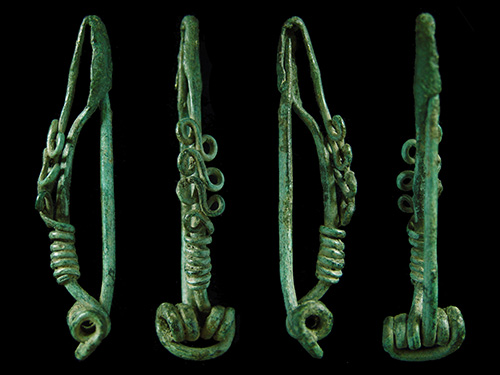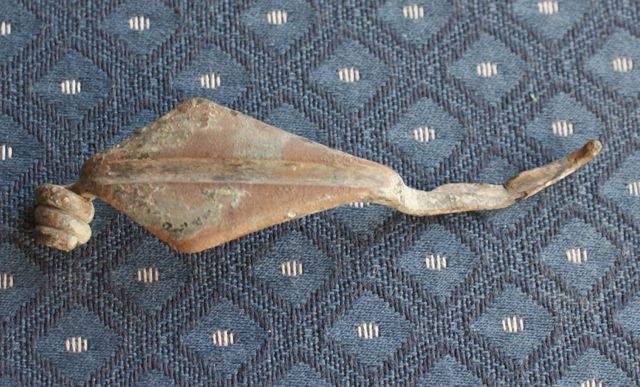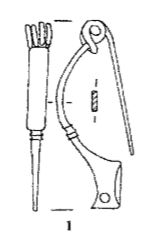Celtic Fibula
Fibulae of the Celtic peoples of late Iron Age Europe. These are divided into La Tene phases I, II and III (early, middle and late La Tene), and early Roman era. Though the fibula types were in widespread use across western, central and eastern Europe there were a few regional variations that deserve separate entry, such as the Geto-Dacian group
Note: La Tène was the second phase of European Iron Age and Celtic culture (c.
480 - 50 B.C.). It takes its name from an archaeological site on the
north side of Lake Neuchâtel in Switzerland, where thousands of objects
deposited in the lake were discovered after the water level dropped in
1857. Le Tène culture replaced the Hallstatt culture after Greek and
Etruscan influences. The La Tène culture was the height of Celtic power
and was characterized
by hill forts, elaborated rich burials and skilled craftsman. The Le
Tène Celts were highly war-like, hierarchically organized with kings, a
priestly class (the Druids), warriors, farmers and slaves. They ruled
central Europe in the 4th and 3rd centuries B.C., but by 50 B.C. they
had been defeated and were dominated by Germans coming from the north
and Romans from the south.
Early La Tène fibula (La Tène I Fibula, La Tène A Fibula)

Van Buchem 13, pl. 2, 1.
Typology: fibula, bow fibula, prehistoric fibula, early iron age fibula, La Tène fibula, Celtic fibula, one-piece construction
References: Van Buchem 13, pl. 2, 1.
Dates: c. 480/400 - 320/200 B.C.
Distribution: Culture: Celtic.
Geography: Switzerland.
Description: Bow fibula, one-piece construction, spring with four turns, tendon (wire connecting two ends of the spring) above the spring. The foot is bent upwards to almost touch bow, though there is sometimes a
small space between. This part of the foot sometimes ends in an animal
head design.

Image: Drawing of an Early La Tène fibula, also called La Tène I fibula, or a La Tène A fibula. The foot is turned up and just touches, but does not connect to, the bow. This example has a bilateral spring with four large diameter winds. This example was found in south Wales. The image is from Houlder, C. & W Manning. South Wales, Regional Archaeologies. (1966).
Middle La Tène fibula (La Tène II Fibula)

Van Buchem 14 - 15, pl. 2, 2 - 3.
Typology: fibula, bow fibula, prehistoric fibula, early iron age fibula, La Tène fibula, Celtic fibula, one-piece construction
References: Van Buchem 14 -15, pl. 2, 2 - 3.
Distribution: Culture: Celtic.
Geography: Switzerland.
Date: c. 320/200 - 150/100 B.C.
Description:
Bow fibula, one-piece construction, spring with four turns, tendon
(wire connecting two ends of the spring) above the spring. Notes: The foot is bent upwards and is attached (tied) to the bow, often by two little wings or extensions which wrap around the bow. The bend at the end of the foot can be rounded or pointed.

Image: The foot on this La Tene II, or Middle La Tene, fibula bends up at the end and is tied, or clipped, to the bow. The waviness of the middle part of the bow is due to damage during burial and was not part of the design. (SC collection)

Image: The foot on this iron La Tene II fibula bends up at the end and is clipped to the bow. This fibula is large - 12.3 cm long (almost 5"). Part of the foot is missing. (SC collection)

Image: The four different view the small La Tene II fibula. This fibula is 43x10x80mm and weighs 2,31g. (Quadrans collection)
Zarubincy Fibula
Typology: fibula, bow fibula, one-piece construction, La Tène fibula, Celtic fibula
Dates: c. 1st c BC
Notes: Has a narrow triangular bow form and a bilateral spring usually with six winds.
Diamond Bow Fibula (Orlea-Maglavit Fibula)
Typology: fibula, bow fibula, one-piece construction, La Tène fibula, Celtic fibula
Dates: La Tene C2 - D1, c. 2nd century BC, used until mid-1st century BC.
Description: Wide diamond shaped bow, often with a groove, and a bilateral spring, usually with six winds.
Distribution: According to Aurel Rustoiu ("Les fibules daciques a ornements anthropomorphes") this type belongs to the Padea-Panagjurskii Celtic culture and originates in the lower Danube region (southern Romania and northern Bulgaria).

Image: Orlea-maglavit (diamond bow) type of La Tene II fibula. The foot is broken and would have turned up and lain along the bow. (SC collection)
Late La Tène Fibulae (La Tène III)
Dates: c. 150 - 30/1 BC
Notes: The form is very similar to the
La Tène II fibula, still one-piece construction, however, the bow section shape and ornamentation is cast rather than hammered.
A sample of bow type B1 .1
Nauheim fibulae (Riha type 1.1) from Riha, E.
Die römischen Fibeln aus Augst und Kaiseraugst.
(1979).
PDF Type: B1.1
References: Riha 1.1 (pl. 1, 1-8), Ettlinger 1.
Geography: Switzerland.
Date: c. End 2nd century B.C. - 14 A.D. Nauheim fibulae| are understood as characteristic for the period La Tène
D1 (Late Iron Age) and are therefore dated end 2nd - mid 1st century BC. However,
Nauheim fibulae| now occur so often at sites of the early Roman
Principate that it is no longer convincing to explain all of them as old
pieces or dislocated finds. Nauheim fibulae were sporadically still
worn by the Celtic population in the second half of the 1st century BC
and until the early Roman Principate.
Description:
Celtic fibula, bow fibula, one-piece construction, spring with four
turns, tendon (wire connecting two ends of the spring) below the spring
(type B1).
Early bow fibula were made from one piece of bronze. The
entire fibula
from the catch, to the bow, to the spring,
to the tip of the pin was created
by shaping and
bending a single piece
of bronze with great expertise
and skill.

Lauteracher
fibula (
Riha type 1.2) from
Riha, E. Die römischen Fibeln aus Augst und Kaiseraugst.
(1979).
PDF Type: B1.2
References: Riha 1.2
Geographic Distribution: A very narrow geographical
area in Northern Switzerland in the
area
of Altenburg-Rheinau (district of Waldshut), Basel-Gasfabrik, and
Augst. There is also another specimen from the Bern-Engel peninsula
Date: c. 1st century B.C. - 30 A.D.
Description:
Celtic fibula,
bow fibula, one-piece construction,
spring with four
turns, tendon (wire connecting two ends of the
spring) below the
spring
(
type B1).
Early
bow fibula were made from one piece of silver or bronze. The
entire
fibula
from the catch, to the bow, to the
spring,
to the tip of the pin was created
by shaping and
bending a single piece
of silver or bronze with great expertise
and skill.
Comments: Very rare. One silver specimen from the 1st century B.C.
Augst Nauheim Variety Fibula
Fibel mit gratförmigem Bügel (
Riha type 1.3) from
Riha, E. Die römischen Fibeln aus Augst und Kaiseraugst.
(1979).
PDFType: B1.3
References: Riha 1.3
Culture:
Celtic. A Nauheim variety,
Riha calls this
type "Fibel mit gratförmigem Bügel."
Geographic Distribution: Found only around Augst, Switzerland.
Date: c. 1st century B.C. - 30 A.D.
Description:
Celtic fibula,
bow fibula, one-piece construction, bow triangular cross-section narrows to the foot,
spring with four
turns, tendon (wire connecting two ends of the
spring) below the
spring
(
type B1), open frame foot.
Comments:
Rare.
Jezerine Fibula

Jezerine Fibulae (Genceva type I, 1, Jezerine, Croatia, 35 B.C. - 10/20 A.D.) from Genceva, E. Les Fibules Romaines de Bulgarie de la fin du 1er s. av. J.-C. à la fin du VIe s. ap. J.-C. (Veliko Trnovo, 2004
Typology: fibula, bow fibula, Celtic fibula, Thraco-Getic fibula, La Tène derived fibula, one-piece construction
References:
Genceva type I, 1 (Jezerine, Croatia, 35 B.C. - 10/20 A.D.); Feugere
253 (southern France), Ettlinger 42 (northern Italy), Fischer 10
(Dalmatia), Bojovic 19 (Dalmatia).
Geographic Distribution: Jezerine fibula
have been recorded in a wide European area, from the western part of
the Mediterranean basin throughout all of continental Europe to the
Baltic, and a large number of them originated in eastern Slavonia,
Syrmia and northern Serbia, an area that, in the Late Iron Age, was
inhabited by a political group known from ancient literary sources as
the Scordisci. Many of these finds can be attributed to the
Jezerine-type II fibulae, which spread to southeastern Pannonia via a
communication route that went through the Sava valley. A smaller group
of finds includes copies of the Jezerine-type fibulae which were
tailored according to the tastes of the local users. The results of the
PIXE analysis of the composition of the alloy from which cast fibulae
were made show quite a heterogeneous picture, indicating that the finds
from southeastern Pannonia were produced in different workshops located
in areas spreading from northern Italy and the southeastern Alpine
region, over the western Balkans to southern Pannonia.
Date:
The Jezerine fibulae are one of the most popular forms of attire from
the Late La Tène period, that is, the LT D2 phase (125
- 15 B.C.). The type was in use into the first half of the 1st century
A.D.
Culture: Scordisci Celts, Thraco- Getic
Early Roman Era Fibula
Late Nauheimer fibula (Riha type 2.1) from Riha, E.
Die römischen Fibeln aus Augst und Kaiseraugst.
(1979).
PDF 
Almgren pl. 1, 17 from Almgren, Oscar.
Studien über nordeuropäische Fibelformen. (Liepzig, 1923).
PDF
Typology: fibula, bow fibula, Celtic fibula, La Tène derived fibula, one-piece construction, Nauheimer fibula
Typology: Celtic fibula, bow fibula, Nauheim fibula
References: Riha 2.1 (pl. 4, 1); Genceva type 1; Almgren pl. 1, 17; Ettlinger -
Culture: Celtic.
Geographic Distribution: Switzerland.
Date: c. Augustan, c. 30 B.C. - 14 A.D.
Description: Celtic
fibula, bow fibula, One-piece
construction, tendon (wire connecting two
ends of the spring) above the spring, held
by spring hook (type B2).
Again, the entire fibula from the
catch, to the bow, to the hook and
plate, to the spring,
to the tip of the pin was created by shaping and
bending a single piece
of bronze
with
great expertise and skill. The
hook holding the spring
was an invention of the Augustan
period, which did not go beyond the
1st century.
Almgren fibula
Almgren 65
Type: B1.7
References: Riha 1.7, Almgren 65, Bohme 15
Culture: Celtic
Geography: Belgium, Scattered finds Novaesium, Saalburg, and free Germania
Dates: c. 80 - 150 A.D.
Notes: These
fibulae were always worn in pairs as part of the women 's costume, as
numerous grave finds from Belgium show. According to the Belgian grave
inventories (inter alia, with coins Domitian and Trajan) the type
belongs to the 2nd century (Böhme 15, note 59). Outside its central
distribution area in Belgium, the type is often found only in Novaesium
and near Saalburg, also isolated finds at several localities in the
Roman provinces and as an exception - in free Germania.
References
Almgren, Oscar.
Studien über nordeuropäische Fibelformen. (Liepzig, 1923).
PDFBinding, U. Band 16: Studien zu den figürlichen Fibeln der Frühlatenzeit. (Bonn, 1993).
Boelicke, U.
Die Fibeln aus dem Areal der Colonia Ulpia Traiana. (Mainz, 2002).
PDFBojovic, D. Rimske Fibule Singidunuma. Muzej Grada Beograda Serija - Zbirke i Legati Katalog XII. (Belgrade, 1983).
Ettlinger, E.
Die römischen Fibeln in der Schweiz. (Bern|, 1973).
Fauduet, I.
Fibules preromaines, romaines, et merovingiennes du musee du Louvre. (Paris, 1999).
Feugere, M.
Les fibules en Gaule meridionale de la conquite a la fin du Ve sicle apres J.-C. (
Paris, 1985).
Available OnlineFischer F. "Frühe Fibeln aus Aquileia" in Aquileia Nostra (1966), pp. 8 - 26.
Genceva, E.
Les Fibules Romaines de Bulgarie de la fin du 1er s. av. J.-C. à la fin du VIe s. ap. J.-C. (Veliko Trnovo, 2004).
PDFMills, N.
Celtic and Roman Artefacts. (Derbyshire, 2000).
Orlic, L. "Iron Age fibulae from the site of St. Theodore 's Quarter at Pula" in
Histria Archaeologica 42 (Nov 1912), pp. 185 - 215.
PDFPopovic, P. "Fibule tipa 'Orlea-Maglavit '" in
Zbornik Narodnog Muzeja u Beogradu 14-1, archéologie (1992), pp. 319 - 326.
Riha, E.
Die römischen Fibeln aus Augst und Kaiseraugst. (1979).
PDFVan Buchem, H.
De Fibulae| Van Nijmegen. (Nijmegen, 1941).
PDF
Working Area

Image: The three different view another small La Tene II fibula. This fibula is 26x9x2mm and weighs 1,18g. (Quadrans collection)
Solid foot. Latter than La Tene II?














